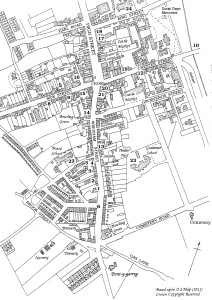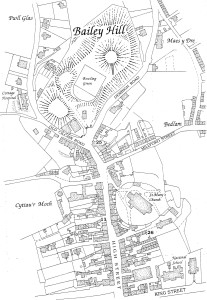by Mervyn Foulkes
If we take a walk around Mold visiting the four main streets, and just off them, we will discover who owned particular shops some seventy years ago and what they did or sold. We can’t possibly look at every one as they numbered at least two hundred and fifteen, and incidentally, none were travel or estate agents!
Let us start by walking up from the bottom of Wrexham Street towards the Cross, taking our bearings from the Ex Servicemen’s Club [numbered 1 on the map] which was built in 1923 and rebuilt in 1938 when it was opened by the then Prince of Wales. Next to this was a shop selling sweets run by a Mr. Sam Evans[2] and next to him a most fascinating premises operated by two ladies selling cooked meats. They were sisters by the name of Jones. Neither of them married. Today we’d call them ‘Old Maids’.[3] What was interesting about this establishment was the fact that they killed their own pigs at the rear. Imagine two ladies doing this. Having slaughtered the animals they would then proceed to scald the body in boiling water, removing the bristles by scraping. This was followed by butchering and the cooking of joints for sale. People who remember this shop say that they made the best sausages, black pudding and savory ducks for many a mile, not to mention the dripping for cooking and putting on a thick slice of bread for snap when working on a farm or down the pit; delicious!
Talking of bread. If we move past the Leeswood Arms public house, then a small pawnshop run by Mr Green [4], we come across a character known as ‘Bob the Baker’. He had a little bakehouse which you could access from a small entry in Glanrafon. [5] This is not to be confused with the nearby Roberts’s Bakery of today with which it had no connection. Here again we see how things have changed in a short space of time. You would take your sack of flour to Bob and tell him what bread you required, i.e. four large and two small tinned, a cob, etc. He would then label your sack and tell you when to collect it if you lived near, or when you could expect it delivered. His deliver)’ boy was a John Parry who carried using a wheelbarrow. Many of us todayremember John as a lad with learning difficulties but a harmless soul who, after his mother died, ended his days in Denbigh Hospital.
When we mention bakehouses all the main streets had at least two. I will mention a few of them. Stanley Stores in Wrexham Street [6] had a very tiny one at the back. Then at the far end of New Street, near the pub Ruthin Castle, there was one run by a Mr. Williams who sold bread and cakes from a small shop on the front, opposite Dutton & Peters’s yard today.[7] Another in New Street was Jones’s located somewhere near the present day Iceland.[8] The old shops have been knocked down here. Then nearer the Cross, which is now Meat n Eat, was a baker and grocer named T.B. Wynne.[9 ] I can also recall one down Chester Street, near the Fitness Club [10], and of course, many of us today remember Thomas Hughes at the top of the High Street, opposite the Church.[11] His son Norbury Hughes continued in business until about the late 1960s. There were others which I shan’t mention, only to say that bread in the 1930s tasted that much better than that produced today. It contained no bleaching of the flour, no preservatives whatsoever, and the smell in Town. Imagine the wonderful smell that wafted around the streets when all these bakeries were in full production at the same lime. Wonderful!
Of course, in the 1930s there were no supermarkets for people to shop at but there were many shops where you could buy your provisions and some were were quite large stores like Bell’s and also Hunter’s, but one that still comes to mind was Sheperd’s, known as Sheperd’s dairies.[12] This was situated down Chester Street, and it was a fact that you could go into this shop with Ten Bob (50p) and come out with enough groceries to feed a family for a week. It would cost you that to cross the town in a bus today.
Back in Wrexham Street at No.44 where we have Mr.Tom Kinsey, tripe dresser, who also delivered by horse and cart. [13] He later moved his processing down Bromfield Lane. Further up on the left, near the Red Lion and next to what is now Roberts Delicatessen, was another tripe seller. This was the premises of Miss Jones, known as ‘Buckley Tripe’. It was a cottage with a split front door like a stable door, the top half of which was open all day for business, also selling pig’s trotters, cow’s heel, etc.[14]
Further up into the town we have to visit the barber for a haircut and the first one we come across is Ted Prince [l5] whose wife also ran a cafe. 1 think it was next-but-one to where Lennox Blundell later sold bicycles? Anyway, Ted continued to cut hair after he retired from his home at Derwen Villas (bottom of Wrexham Street)and as a child of perhaps seven or eight I would be sent to him after school for my haircut. The price I well remember was a ‘tanner’ or sixpence; two and a half pence today. Having knocked at his front door you would be shown to a chair in the parlour and his enquiry would always be, ‘How do you want it?’ To which 1 always gave the same reply. ‘A sixpenny all off Mr. Prince, please.’ Meaning of course that cut very short the interval between haircuts would be longer than perhaps you would like but we know it was done to save money. Once seated he would proceed to cut your hair, but sure enough, as soon as he started clipping his wife would shout him for his tea and he would leave you half done while he went to eat. He’d return in about 30 minutes to complete the job! Another barber in the town was a Mr. Barnett. His shop you entered from behind the Assembly Hall where there is now a small car park.[l6] Barnett was also the Chief Fire Officer. The Fire Station at that time was in King Street opposite the present day car park there. He was in charge of the then horse-drawn fire engine. Can you in visage them going at full gallop through the streets of Mold? What a wonderful and exciting sight we miss today; although nobody wants a fire!
A Mr. Bob Ansell had a barber shop in the High Street, next to the Black Lion Hotel.[17] One of his daughters had a shop famous for its ‘blend your own’ tobacco at the corner of King Street [18], while another daughter kept a sweet shop opposite the Savoy Picture Palace down Chester Street. [19] The previously mentioned Black Lion Hotel, whose front door has survived behind two pillars near Woolworths, was famous in the 1930s for its dance floor. Many, many people would arrived there by pony and trap or horse-drawn carriage where a hostler would meet them and take the horses to the stables at the rear to look after until the visitors were ready to depart. Before leaving this particular hotel it is worth reminding ourselves that during World War II it played a small part in a plan to dupe the Germans. The Secret Service arranged for a body in British uniform to be discovered on the Spanish coast. Amongst the items deliberately placed on the corpse was a letter written on headed notepaper from the Black Lion Hotel. This, with other material, was part of a plan into lulling them to think that the allies were planning to invade by way of beaches other than Calais. It worked!
On the Cross itself, on the Wrexham Street • Chester Street corner, stands Crompton House.[20] This, like the Black Lion, has two pillars at its front door. At the beginning of the twenty first century it houses a cobbler and a travel agency. Seventy years ago it was a drapery shop which took up both sides of the building. In fact, it was one of the last shops in Mold to use overhead wires on the premises to convey orders or instructions around the different departments and to the office. A few doors away, down Wrexham Street, we also remember Wynne Williams the Chemist [21] who had a cure for everything – and while 1 remember – people used to make their weekly pilgrimage to his shop with a bottle to buy six-pen’ worth of syrup of figs to keep all the family regular throughout the coming week. Ugh! As a child you were sent for this and the trick was to buy five-pen’ worth and spend the other penny on sweets!
Education in the town was made up of Government, Church and private schools. The former together with the county regulated ‘The Board School’ in Glanrfon [2 2] and the Alun Grammar in Victoria Road [23]. The National School in King Street [2 4] belonged to the Church and was conveniently situated near St. Mary’s and the Vicarage. There were two private schools. One was located opposite the entrance to Bailey Hill. ‘The Limes’, as it was called, was run by a Miss Jones.[25] The other in Church Lane was managed by a Miss Smith.[26] These last mentioned were Girls’ Day Schools offering private education. A further offering on education was emanated from, yet again, a shop in Wrexham Street. It was David Arthur’s tailor shop. He had served his apprenticeship with the novelist Daniel Owen. His daughter, always known as ‘Miss Arthur’ taught generations of Mold people, including myself, up until the 1940s. She was head lady teacher at the Board School. She will also be remembered for standing in front of the fire in class with her skirt hitched up to warm her backside. Even today, if you mention her name to those taught by her the first thing they will say is. ‘Remember, she used to lift her skirts to warm herself!’ It was her personal trademark.
Where, oh where, will these characters come from today? Only time will tell.
Copyright of articles published in Ystrad Alun lies with the Mold Civic Society and individual contributors. Contents and opinions expressed therein remains the responsibility of individual authors.

